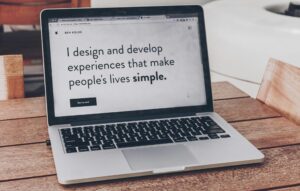“The power of the Web is in its universality. Access by everyone regardless of disability is an essential aspect.” – Tim Berners-Lee
The above is one of my favourite quotes when it comes to my work as the QA Practice Lead here at Remarkable. I do believe that the web should be a place where everyone feels welcome and can easily access information and services. But the reality is, many websites and digital products aren’t designed with accessibility in mind. This is a problem, especially when you consider that roughly 20% of users have some form of disability that affects how they interact with the digital world.
“the reality is, many websites and digital products aren’t designed with accessibility in mind.”
Imagine trying to navigate a website with a screen reader because you have a visual impairment, only to find that the images lack alternative text descriptions, or the headings are poorly structured, making it impossible to understand the content. Or perhaps you rely on keyboard navigation due to a motor disability, but the website’s interactive elements aren’t properly coded, leaving you unable to complete key tasks. These are just a few examples of the barriers that people with disabilities face online every day.
Ignoring accessibility isn’t just bad practice; it can also have serious consequences for your brand and your bottom line. In 2023 alone, over 4,600 lawsuits were filed in U.S. courts related to digital accessibility issues. And with the European Accessibility Act coming into full effect in June 2025, the legal landscape is only going to get tougher.
But here’s the thing: prioritising accessibility isn’t just about avoiding legal headaches. It’s also a smart business move. When you create inclusive digital experiences, you tap into a wider audience, build trust with your customers, and ultimately drive better business outcomes.
So, how can you ensure your digital products are accessible to everyone? Here are 6 key practices to keep in mind.

The Web Content Accessibility Guidelines (WCAG) are the gold standard for digital accessibility. Developed by the W3C, these guidelines provide a comprehensive framework for making web content perceivable, operable, understandable, and robust. WCAG 2.1 is the current version, with 2.2 bringing further enhancements.
Following WCAG helps you avoid legal issues and ensures a positive user experience for everyone, including those with disabilities.
Understand the basics: Familiarise yourself with the four main principles of WCAG: Perceivable, Operable, Understandable, and Robust. These principles form the foundation of accessible web design.
Break it down: Don’t feel overwhelmed by the sheer volume of WCAG guidelines. Start by focusing on the most critical ones and gradually incorporate more as you become more comfortable.
Use resources: There are tons of helpful resources available to guide you on your accessibility journey. Checklists, guides like the WCAG Quick Reference Guide, and online tools can make a big difference.
Automation is your secret weapon in the fight for accessibility. By integrating automated accessibility checks into your development workflow, you can catch issues early on and prevent them from becoming bigger problems down the line.
Tools like Axe, Lighthouse, and Pa11y are your automated accessibility allies. They can be easily integrated into your development environment, constantly scanning on every deployment or pulling requests for potential issues and providing valuable feedback.
Catching accessibility issues earlier means less rework and lower costs; this also aids a shift left mentality. Plus, automation ensures consistency and covers a wide range of issues, especially those repetitive ones that can make manual testing tedious.
Set up automated scans to flag common issues like missing image descriptions (alt text), poor colour contrast, and keyboard navigation problems. However, don’t rely solely on automation – combine it with manual reviews to catch those trickier accessibility barriers that automated tools might miss.

Automated tools and manual checks are essential, but they can’t replace the invaluable insights gained from real-user testing. Involving people with diverse disabilities in your testing process is crucial.
Usability sessions with people who use assistive technologies or have specific accessibility needs can reveal hidden challenges that you might miss otherwise. They can provide firsthand feedback on how your product works in the real world, highlighting areas that might be frustrating or difficult to use for people with disabilities.
Real-user feedback ensures your product isn’t just ‘technically accessible’, but actually usable in the real world. It helps you uncover those subtle issues and get authentic feedback on the overall experience.
Accessibility isn’t an afterthought; it’s a core design principle. Inclusive design means considering the needs of all users from the very beginning, not just fixing things later.
“Accessibility isn’t an afterthought; it’s a core design principle.”
It’s about creating products that are equitable, flexible, simple to use, and easy to understand. It’s about designing for people with different abilities, languages, cultures, and backgrounds.
By including accessibility into your design process, you’re building a solid foundation for an inclusive product. This proactive approach not only saves time and resources in the long run, but also leads to more usable and user-friendly products for everyone as well as spreading awareness and upskilling other areas of your business.

Accessibility needs to be consistent, no matter how someone accesses your product. Whether they’re on a desktop, tablet, mobile phone, or using assistive technology, the experience should be seamless and inclusive.
Different devices come with different accessibility challenges. Small screens, browser quirks, and assistive technologies like screen readers all need to be considered.
Use screen readers like NVDA, JAWS, and BrowserStack to experience your product from the perspective of someone with a visual impairment. This will help you identify any barriers that might prevent them from accessing your content or completing tasks.
Test thoroughly on a range of devices and browsers to catch those pesky environment-specific issues. Accessibility should be consistent across all platforms, so make sure you test on different operating systems, screen sizes, and browsers.
Achieving comprehensive accessibility can be tricky and complex as well as time and resource consuming. Partnering with experts and leveraging cutting-edge technology can streamline the process and ensure your digital presence is truly inclusive.
Remarkable has partnered with accessiBe, a leading provider of AI-powered accessibility solutions, to offer our clients a seamless path to WCAG compliance. accessiBe’s innovative AccessWidget uses AI and automation to make websites more accessible, catering to users with various disabilities and adhering to WCAG 2.1 standards.
Expertise: Remarkable’s deep understanding of accessibility best practices, web design and technical ability combined with accessiBe’s advanced AI technology, provides a powerful solution for your accessibility needs. We bring together the best of both worlds: human expertise and cutting-edge technology.
Efficiency: AI-powered solutions can automatically identify and remediate a wide range of accessibility issues, saving you time and resources. This allows you to focus on other aspects of your business while ensuring your website remains accessible.
Comprehensive Coverage: accessiBe’s AccessWidget addresses a wide array of disabilities, ensuring an inclusive experience for all users. It goes beyond basic compliance to provide a truly user-friendly experience for everyone.
Ongoing Support: Remarkable provides ongoing support and guidance to ensure your website remains accessible as it evolves. We’re not just here to help you achieve compliance; we’re here to support you on your ongoing accessibility journey.
Accessibility isn’t just about compliance; it’s about creating a digital world where everyone feels welcome and empowered. By embracing these 6 key practices, you can ensure your digital products are inclusive and user-friendly for all.
Need help getting started? Remarkable is a digital experience agency that specialises in creating inclusive and accessible digital experiences. Our expertise in experience platforms, data analytics, and performance marketing can help you build a website that not only meets accessibility standards but also delivers exceptional user experiences for everyone.
Ready to create a more inclusive digital experience? Contact Remarkable to learn more about our partnership with accessiBe and how we can help you achieve your accessibility goals.
Remarkable are one of the world’s leading digital experience agencies. As a double Platinum Sitecore and Optimizely partner, we offer technology solutions to help brands build experiences that convert.